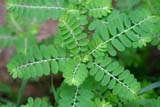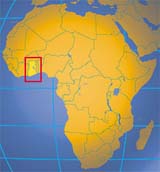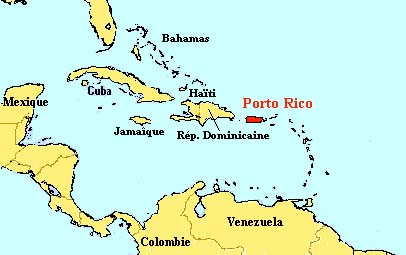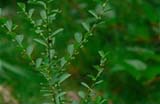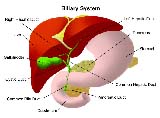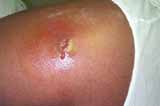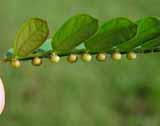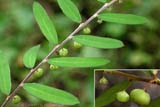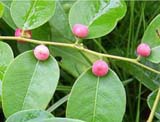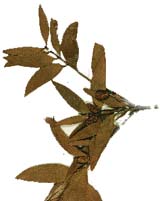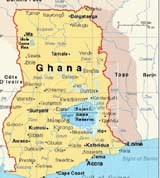Medicinal plants
Bhūmī āmalakī, Phyllanthus
I. PHYLLANTHUS NIRURI, LINN.
Of the five species of the genus Phyllanthus, P. niruri, Linn. is the most famous. Even practising allopathic physicians recommend its freshly extracted juice as a cure for patients suffering from jaundice.
Names
The annual herb Phyllanthus niruri is best known by the common names of stone-breaker, seed-under-leaf in English, chanca piedrain in Spanish and quebra pedrain in Portuguese. It has many other common names in assorted languages
In India, where it has been used for milleniums, it is called Bhūmī āmalakī, bahupatra (many-leaved), bhūdhātra (a ground āmalakī), kṣetramali (little āmalaka of the cultivated fields) and sūkṣma phala (small-sized fruits) in Sanskrit; jaramla and niruri (forming the term in the botanical name) in Hindi; bhuiamla in Bengali; bhuiavala in Marathi; nellaneeli (the ground amalaka) in Kannada; kila nelly (amalaka borne at a low level) in Tamil and Malayalam; and nelaustrika in Telugu.
Botany
Phyllanthus niruri is a small, erect, annual herb that grows 30–40 cm in height. The main stem quite often branches at the base, producing many leafy branches in a clump. These branches are slender and spread out on all sides around the central axis. The leaves are plentiful and almost stalkless; they are elliptic or oblong in shape with obtuse tips. The seeds are characteristically arranged in double rows at the base of the leaves. The flowers are small and axillary to the leaves; they are yellowish, green or whitish in colour. The fruit is a capsule and eventually dries and breaks open to release its seeds within. The green fruit resembles the āmalaka fruit, which is why it is called bhūmī āmalakī
Recent findings
The dried leaves contain 0.4 per cent of a toxic bitter principle named phyllanthine (after the generic name) and this is the chief medically active substance of the plant. It is found to be poisonous to fish and frogs. In frogs, it causes depigmentation of the skin although this is regained after about 20 hours. The leaves are very rich in potassium, considered to be responsible for its powerful diuretic effect — the basis for its most celebrated use in jaundice.
The stem contains saponin, a detergent or cleaning substance. A decoction from the stem and leaves is used to dye cotton threads black; in fact, this decoction is so black that it is sometimes used in place of ink. An alcoholic extract of leaves and roots exhibit anti-bacterial activity against micrococcus pyrogenes, the pus causing bacteria and Escherichia coli.
Traditional medicine
Āyurveda considers the plant astringent, sour and cooling in action. It destroys aggravations of pitta and prameha, correcting any obstructions in the urinary flow, quietens the thirst as well as douses any burning sensations. Bhavamishra believes it promotes vāta and is beneficial against coughs, raktapitta (plethora), vitiations of kapha and jaundice. The nighaṇṭu compiled by Shodala, a later classical scholar of Āyurveda, goes so far as to state that the plant cures poisoning.
The (unripe) fruit and plant are acrid and sour. As a drug material, it is also considered astringent, deobstruent (removing obstructions in the passages), stomachic (good for the stomach), diuretic (promoting urine flow), febrifuge (useful at warding off fever) and antiseptic. It is considered good for healing sores. Yunānī physicians consider it to be beneficial against tubercular ulcers, wounds, sores, unsightly spots, bruises, scabies and ringworm.
Uses in traditional medicine
1. Gastro-intestinal system
It is used for relieving many afflictions of the abdomen, such as dyspepsia, colic, diarrhoea and dysentery.
i. An infusion of young tender shoots can be effectively given against chronic dysentery.
ii. The leaves are also boiled in water and the liquid drunk to arrest acute gripping pains in the stomach.
iii. The most important medicinal value of the plant lies in its sure use against jaundice. For this purpose, a tolā of fresh juice from the ground root is given in the early morning along with milk. This is to be taken twice a day, once in the morning and then before bedtime.
iv. Gargling with a cold extract of leaves will cure sores and inflammations in the mouth (mukha pak).
v. Sprue
Sprue is a chronic, chiefly tropical disease, characterised by diarrhoea, emaciation, and anaemia, caused by defective absorption of nutrients from the intestinal tract. Giving some tender leaves of the plant, along with the seeds of methi (fenugreek), will set right this chronic and longstanding disorder.
vi. Edema
A decoction from the whole plant mitigates morbid swellings, due to the retention of fluids in the body or dropsy (jalodara), by inducing profuse urine flow.
2. Skin
i. The roots and leaves are pulverised and made into a paste along with rice water and applied externally as a poultice to lessen morbid swellings and ulcers.
ii. The milky juice from the plant is a good application against offensive and foul smelling sores. It is also found to be effective for difficult and painful tumours.
iii. A poultice, made from the leaves with salt, cures scabby afflictions and this poultice (without salt, to avoid burning) can also be applied on open lesions and bruises.
iv. An application of the poultice prepared from its leaves cures itching, aberrations and eczema.
v. A decoction from the roots is used as a cooling reagent for the scalp.
3. Genito-urinary problems
The plant increases the quantity of urine and also removes burning associated with its flow. Because of this, it is recommended against gonorrhoea as well. In brief, the plant is very effective for all diseases of the urinary tract, ranging from the kidney to outflow of urine.
i. In cases of new gonorrhoea, administration of a spoon of fresh juice from the plant, along with sugar and jira, considerably mitigates any pain in urination.
ii. In the Konkan region, the root is ground down with rice water (conjee) and given as a remedy for menorrhagia or excessive menstrual flow.
iii.In the Gold Coast of Africa, the leaves are pounded and used to cure gonorrhoea.
iv. A paste from the entire plant is applied externally to reduce morbid swellings of the breasts.
v. The juice from fresh roots is taken internally along with milk as a galactagogue (i.e. promoting milk formation in lactating women).
4. Fever
i. A liquid decoction from the root and leaves is very bitter but a favourite and efficient remedy amongst the natives of Porto Rico in the West Indies for the cure of intermittent fevers. The expected paroxysm (i.e. the climax stage) of such a fever can be prevented by its use. The dose is two drachms in the morning when onset is feared. An infusion of roots and leaves is a good tonic and also a diuretic when taken in repeated doses.
ii. A decoction from the whole plant is given against malarial fever. After administration, the stools become normal and sweating commences. The patient secures sleep. Any enlargement of liver and spleen, which often accompanies longstanding fever, subsides and slowly the incidence of intermittent attacks stops.
iii. Intermittent fever
A paste is prepared by grinding its tender leaves along with black pepper. A pellet is made from it, the size of a nutmeg (jayphal) and given for all intermittent fevers including malaria.
5. Eyes
When mixed with oil, the juice from the plant is useful against inflamed eyes.
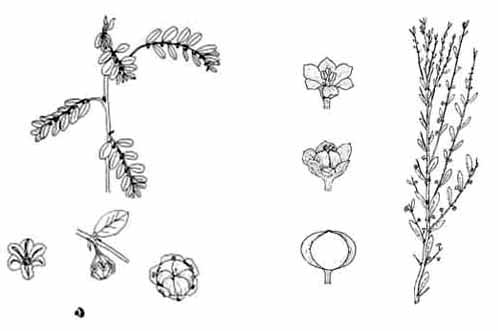
Phyllanthus niruri, Linn. Phyllanthus maderaspatensis, Linn.
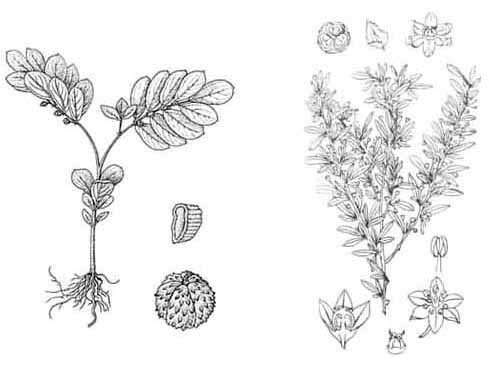
Phyllanthus urinaria, Linn. Phyllanthus simplex, Retz.
II. PHYLLANTHUS MADERASPATENSIS, LINN.
This plant was first described by botanists at the grounds around the city of Madras. So it is commonly known as the Madras leaf-flower
Names
It does not seem to have any Sanskrit name. It is known as kanocha, kanauka and hazarmani in Hindi; marur in Arabic; morurshat in Iranian; kanocha in Gujarati; nala usarika (the good arnalaka) in Telugu; and mela nelli; madras nelli (the good āmalaka from Madras) in Kannada.
Botany
This is a much bigger plant than the first and is either found erect or decumbent (i.e. growing along the ground as if it is lying on it). It is found throughout drier parts of India. It also grows quite commonly in the drier parts of Africa, Arabia, Java, the Far East, China and even Australia. The Madras leaf-flower is an erect or spreading sub-shrub, growing to only 50 cm tall; it is well-branched and hairless. The leaves are arranged in two they are inverted, lance-shaped or obovate, 1-4 cm long, up to 5 mm wide. On the underside, there is a glaucous tip which is blunt or rounded with a sharp point. The stipules have white margins. The male flowers arise two or three together with one female. The male flowers are on stalks up to 0.5 mm long while the female flowers are on longer stalks. up to 1 mm long. The female flower petals are obovate with white margins, 2 mm long and 1.5 mm wide, twice the size of the male petals. The capsule is about 3 mm in diameter, with the seeds being 1-1.5 mm long. The seeds are somewhat like those of linseed (aiasi or Linum usitatissium, Linn.). They are brown, soft, smooth, slippery and triangular, rounded on the back and beautifully marked like basketwork.
Properties
Extracts of Phyllanthus maderaspatensis were found to contain resins, steroids, triterpenoids, alkaloids, phenolic compounds, tannins and saponins, but no glycosides. The plant also contains the lignans phyllanthin and hypophyllantin, which are responsible for hepatoprotective activity, but in low concentrations.
Butanol, ethanol and water extracts of the whole plant were found to bind hepatitis B virus and E antigens. The n-hexane extract was found to have a pronounced hepato-protective activity and showed anti-oxidant activity and stimulation of bile production. The antioxidant activity is attributed to the phenolic compounds. The results of tests in mice clearly indicated that an ethanol extract has a protective effect against adriamycin-induced toxicity and it also showed an anti anti-oxidant effect.
The plant has shown anti-bacterial and anti-fungal activities. The seeds have confirmed laxative, carminative and diuretic properties. Many of the medicinal uses of the plant are related to the astringent action of tannins.
A clear deep yellow oil can be extracted from the seeds. It contains myristic, palmitic, stearic, oleic and linolenic acids and B-sitosterol. The defatted seed cake contains a fibrous mucilage which can be hydrolysed to galactose,arabinose, rhamnose and aldo-binic acid.
The plant is treasured by Yunānī physicians. According to them, its seeds (the most useful part) are second-degree hot and first-degree dry (rūkṣa). Its medicinal actions include: clearing obstructions, dissolving morbid swellings of wounds, mucilaginousness (slimy) and mitigating vitiations of the body. When soaked in water, the seeds absorb the liquid and swell up to display a fine coating all round. It is due to this property that they find their use in medicine.
Uses in traditional medicine
1. Respiratory problems
The leaves are expectorant (helping discharge of phlegm from the throat) and diaphoretic (inducing sweating).
2. Headache
In southern India, an infusion is made from leaves and applied on the head to relieve headache.
3. Genito-urinary problems
i.The leaves are useful against urinary obstructions.
ii. If the seed mucilage is given along with jasmine oil, a patient with pitta aggravations will get relief.
4. Gastrointestinal problems
i. The seeds have a bad taste but they have useful medicinal properties. They are a carminative, laxative, tonic to the liver and also a diuretic.
ii. Stomach pain
If the seeds are given internally, they strengthen the liver and intestines, offering relief from pain. In fact, they are given after frying, either by themselves or along with other suitable drugs, for dysentery with blood and diarrhoea.
5. Abcesses
i. Many Yunānī physicians consider the seeds of this plant much better than those of linseed at hastening abscesses to maturity and so ultimately curing them. For this purpose, the seeds are ground, mixed with honey and then applied. The seeds are slimy and mucilaginous and therefore useful in all cases where such action is required.
ii. A poultice made from its leaves is applied externally and tied over boils, pustules and hard abscesses with quite good effect.
6. Ear ache
If the seeds are removed from their outer coating, mixed well in breast milk and then a few drops placed in the ear, any shooting pains in the ears will be relieved.
III. PHYLLANTHUS URINARIA, LINN.
This plant is so named because it corrects many urinary disorders.
Names
This herb does not seem to have any name in Sanskrit, though occasionally the term tāmravallī (coppery creeper) is used. It is called hazarmani or lalbhuiavala (red āmalaka that grows near the soil) in Hindi; hazarmani in Bengali; kharsat, bhumiavaali in Gujarati. Its name in many other languages implies that it is a shrub which is red in colour. These names are lalmundaz avail in Marathi, erra ustrika in Telugu and kempu nellanellii in Kannada. It is called shivappu nelli (the red āmalaka) in Tamil.
Botany
The plant, reaching around 2 feet, has small alternate leaves resembling those of the mimosa tree, disposed in two ranges. The leaves are large at the tip and smaller towards the petiole. When touched, the leaves fold inwards automatically. The flowers are a greenish-white, minute and appear at the axils of the leaves, as well as the seed capsules. Numerous small green-red fruits, round and smooth, are found along the underside of the stems, which are erect and red.
This plant is considered a competitive weed in some regions, because of its great number of seeds, its high shade tolerance and extensive root system.
Medical Importance
The plant is diuretic, astringent and cooling. In the form of a decoction, it is used against jaundice and gonorrhoea. It is useful in cases of thirst, bronchitis and also leprosy. In general, the plant is used much in the same manner as P. niruri, Linn. and, in fact, is very often employed as a substitute for it. A decoction from the dried plant is given in a dose of one teaspoon to ward off jaundice. Because of its excellence as a diuretic, it is profitably used for removing morbid fluid collections in the body or dropsy (jalodara). The tribals of Chotanagpur use the root as a mild sedative to get small children to sleep, whilst the juice from the leaves is given in coconut milk as an appetizer to children. The leaves are also well liked by cattle.
On the islands of La Réunion, the plant is used as a diuretic, sudorific (causing sweat), and as a purificatory and regulatory agent for menstrual flow.
In Cambodia, the plant is used as a tonic, astringent and febrifuge (relieving fever).
IV. PHYLLANTHUS SIMPLEX, RETZ.
This is a slender, erect, simple or slightly branched, smooth, annual herb 20 to 50 cm in height. The stems are flattened and usually purplish. The leaves are two-ranked, oblong-linear, 1.5 to 3 cm long, and 6 to 9 mm wide. The flowers are very small, solitary, and borne on the axils of the leaves. The capsules are smooth, depressed-globose, and 3 to 3.5 mm in diameter.
It grows all over India, Sri Lanka, Malaysia, China and the Pacific islands.
Names
No names seem to exist for this plant also in Sanskrit. It is called moti bhui avail in Gujarati and Marathi, a term meaning ‘a bigger bhūmī āmalaka’, which is precisely what the plant is. The Telugu name, ucchi usarika denotes the same.
Recent findings
The fruit has been shown to contain an oxalic acid, also found in another popular herb with a sour taste, Oxalis Corniculata, Linn.
Uses in traditional medicine
This widely distributed plant finds many useful applications in medicine.
i. According to Kirtikar and Basu, and Caius, Indians use equal parts of the fresh leaves, flowers and fruit, and jīraka (cumin seeds) with sugar, made into an electuary, for the cure of gonorrhoea. A teaspoonful is given twice a day.
ii. Its fresh leaves, reputed to contain antiseptic properties, are crushed and mixed with buttermilk to make a medicated wash to cure itching in children.
iii.The root is used in Chota Nagpur as an external application for healing abscesses of the breasts.
iv. In the Philippines, the juice from the leaves is used to cure eye diseases.
V. PHYLLANTHUS RETICULATUS, POIR.
Phyllanthus reticulatus is usually a dense deciduous shrub or small tree with a distinct smell that is emitted by minute flowers when they open towards the early evening. It is one of the fascinating and characteristic smells of Africa. It frequently grows along water courses, but also in scrubs and hedges, on waste places, and in mixed evergreen forest. It is found in India and Taiwan at up to 2000 m altitude. This species is often common in moist places.
P. reticulatus is found throughout the Old World tropics. In Asia it is widely distributed from India and Sri Lanka to southern China and the whole of south-east Asia.
Names
This herb does have a few names in Sanskrit, Kṛṣṇa kambhoji (referring to the darkish āmalaka-like fruits), bahupṣpā (many-flowered). It is called buinowla and panjoli in Hindi; pajuli in Bengali; Krishna nelli (dark amalaka) in Kannada; and karup puphilanji (darkish philanji) in Tamil.
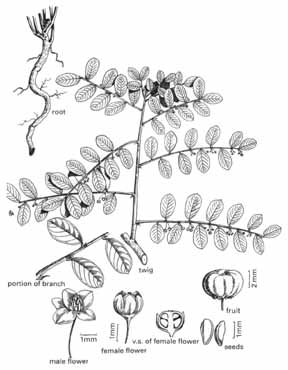
Botany
A monoecious scandent shrub or small bushy tree, up to 5 m tall (in Africa rarely upto 18 m tall); trunk upto 15 cm in diameter, bark rough, brown to grey, branchlets slender. Leaves: differently shaped; spirally arranged scale-like, ca. 1.5 mm long on orthotropic shoots; plagiotropic shoots with normally developed, distichous, elliptic to (ob)ovate leaves, 1-3(-5) cm x 0.5-2(-2.5) cm, entire, cuneate to rounded at base, obtuse to emarginate at the apex, glabrous and shortly petiolate. Flowers: in few-flowered fascicles or solitary in leaf axils, uni-sexual, often a single female flower and some male flowers together, sometimes arranged on leafless shoots and those then seemingly long racemes, with 5(-6) perianth lobes and 5(-6) disk glands; male flowers with 5(-6) stamens; female flowers with a superior subglobose ovary, crowned by two-lobed styles. Fruit: a depressed-globose berry, up to 7 mm in diameter, usually a blueish-black when ripe with a dark purplish pulp, 6 and many-seeded. Seeds: trigonous and upto 2 mm long and blackish. The indumentum of leaves, stem and flowers is variable, from glabrous to densely pubescent. In Africa, two varieties have been distinguished: Var. reticulatus with pubescent flowering shoots and sometimes also leaves and stems, and Var. glaber (Thwaites) Muell. Arg. with all its parts glabrous.
Recent finding
The leaves and bark contain tannic acid, gum a new purine derivative, 3-(3-methylbut-2-en-1-yl)isoguanine and a new cleistanthane-type diterpenoid glucoside, together with eight known compounds were isolated from the whole plant of Phyllanthus reticulatus. The structures were elucidated by chemical and spectroscopic methods.
Uses in traditional medicine
i. The fruit is astringent and useful against aggravations and inflammations due to vāta doṣa and diseases of the blood. The bark is alterative (capable of making beneficial changes in the body’s vital functions) and attenuant (thinning fatty tissue). The dosage is about four ounces or more, twice daily in the form of a decoction.
ii. The leaves are employed as a diuretic and cooling medicine in the Sind, where the plant grows profusely along the banks of the Indus.
iii. In the Konkan region, the leaf’s juice is made into a pill with camphor and cubeb (dried berries of Piper cuba) to dissolve in the mouth as a remedy for spongy and bleeding gums.
iv. In the Lakhimpur area of Bengal, the juice from the leaves is used against diarrhoea in infants. It is also reduced into a thin extract along with the juice of other alterative medicinal plants and made into a pill with aromatics. The pill is then given twice a day followed by a cup of milk in order to lessen heated blood.
v. A decoction from the bark (1 in 20) in doses of 1 to 2 fluid ounces or infusion of leaves (1 in 10) in doses of 1 to 2 fluid ounces is given as an astringent, diuretic and alterative drug.
vi. In Ashanti in Africa, the leaves are mixed with nuts from a local palm tree (Elaeis guinensis) and made into a broth and then given to women who have just delivered to relieve them from pain.
vii. On the Gold Coast, the juice from the stems is blown into the eyes to cure soreness.
viii. East Africans employ the powdered leaf as a local application for sores, burns and pus-filled wounds as well as for any chafing of the skin.
Bibliography
1. K.M. Nadkarni. Indian Materia Medica, Vol. I. Mumbai; Popular Prakashan Private Ltd., 1982.
2. K.R. Kirtikar and B.D. Basu. Indian Medicinal Plants, Vol II. Dehradun; International Book Distribution, 1988.
3. Naveen Patnaik. The Garden of Life. New Delhi; Harper Collins Publishers, 1993.
4. N.K. Shanmugam. Mooligai Kalai Kalanjium. Chennai; Kalaiselvi Publications, 1997.
5. P.K. Warrier, V.P. Nambiar, C. Raman-kutty. Indian Medicinal Plants. Chennai; Orient Longman Limited, 1996.6. The Wealth of India. New Delhi; Publications and Information Directorate, CSIR, 1976, [Vol.X]: 171-7.
7. The Useful Plants of India. New Delhi; Publications and Informations Directorate, CSIR, 1986.
8. Bhandari, Chandraraj. Vanauṣadhī Cand-rodaya. Varanasi; Chaukhambha Sanskrit series, 1970.
9. Schmelzer Gabriëlla Harriët, Gurib-Fakim Ameenah. Plant Resources of Tropical Africa 11(1),Medicinal plants 1. Wageringer, Neths; Prota Foundation, Backhuys Publishers, 2008.
Dr. K.H. Krishnamurthy wrote about medicinal plants as used in the Indian context with deep interest.
Share with us (Comments,contributions,opinions)
When reproducing this feature, please credit NAMAH,and give the byline. Please send us cuttings.

